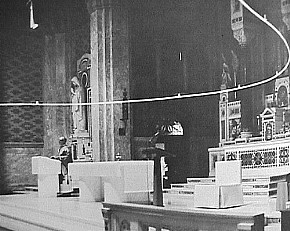01052301 rems models 231ai11
01052302 rems models 231ai12
01052303 mesh surface cubed distorted models 231ai13
b
| |
2005.05.23 14:27
hotrod architecture
Anyone familiar with Venturi and Rauch's Renovation of St. Francis de Sales, Philadelphia 1968 (which is best illustrated in the original Learning From Las Vegas) will have to agree that it was a bone-fide "hot rod" design. Sadly, the design is no longer in place (but at least the white plastic lectern still exists, albeit in storage). The single tube of white neon that hovered over the church sanctuary apparently didn't last long at all. Like the ecumenical changes of Vatican II, the Renovation of St. Francis de Sales was indeed an "extreme makeover."

| |
2005.05.23 15:41
nice urban housing in philadelphia
Perhaps Philadelphia's vast housing stock has always been quotidian bricolage.
bricolage: something made or put together using whatever materials happen to be available
quotidian: everyday; commonplace
06052301 Dominican Villa Savoye model 2365i01 b c d
06052302 Dominican Villa Savoye plans 2365i02 b
06052303 Dominican Villa Savoye perspectives 2365i03
13052301 District Q NNTC, plan development 2170i39
| |
2013.05.23 09:59
What are the cultural ingredients of architecture today?
Is FACTUM arte a possible proto-type of future architectural business? Like the architect could spec Duchamp Fountains for all the men's rooms to add some culture to the act of purgation.
Is the real value then in the 3D data file that tells the 3D printer what to do?
(Although I very much doubt I'll personally get to see it, nevertheless) Could someone that inherits all of Quondam's 2D and 3D file data someday in the future decide to 3D print it all out and thus make an actual Museum of Architecture?!?
note to self: rewrite my will to make sure I bequeath all of Quondam's data to an entity that has the money and operation to actually turn Quondam into a reality. I'm sure Disney could do it, but it would be funny to leave it all to China. Why am I leaning toward Dubai?
Next time someone asks me what I do, I'll tell them I'm very busy becoming posthumously famous.
2014.05.23 13:28
17 May
When I started to redraw the Ichnographia (via CAD in 1987) I had no knowledge of the 'philosophy of history' notion of reenactment. Soon after learning about the 'philosophy of history' notion of reenactment (in 1997), I realized that my redrawing of the Ichnographia was a form of reenactment. It was exactly like learning about the workings of reenactment while unwitting performing a reenactment, where, thus, second-hand knowledge (of reenactment) quickly became first-hand knowledge (of reenactment).
| |
15052301 NPApraksin District IQ02 IQ03 GAUA plans 2438i00
15052302 NPApraksin District IQ02 IQ03 GAUA plans model 2438i01
15052301 Cadaval & Solŕ-Morales Sunflower House Port de la Selva
18052301 Philadelphia plans iq14 15 16 18 19 20 22 23 24 26 27 28 2093i77
19052301 iqq15 Analogous Museum of Architecture Acropolis of Contemporary Art New Atheneum Mies van der Hejduk Quondam House Section House ASouq Neighborhoods ASouq 003 ASouq 002 Mat-Slab-Blob Complex Maison l'Homme + Wall House 2 Complex Religious Working Title Museum 005 Netherlands Embassy Berlin House for Karl Friedrich Schinkel 004 House for Karl Friedrich Schinkel 001 Dresdner Bank Housing for La Villette Wallraf-Richartz Museum Breslauer Platz Olivetti Headquarters Milton Keynes Florey Building Cambridge History Faculty Building Leicester University Engineering Building International Planning Competition for Berlin Philadelphia plans 2468i78
19052302 iqq19/15 Philadelphia International Planning Competition for Berlin Wallraf-Richartz Museum Breslauer Platz ASouq 002 ASouq 003 Altes Box Museum plans 2200x1100 2468i79
20052301 hyperarchitecturism iqq15 model work east of Broad Street Dresdner Bank Housing for La Villette 2468i100 b
20052302 Stonehenge plus half plans 2489i17
20052303 whole plans 2489i18
20052304 half plans 2489i19
20052305 Pantheon plus half plans 2489i20
20052306 Minerva Medica plus half plans 2489i21
20052307 Tempietto plus half plans 2489i22
21052301 Schizophrenic Fold 3 in 3 to-scale contexts plans 2307i32
|